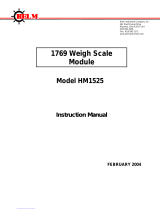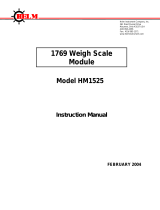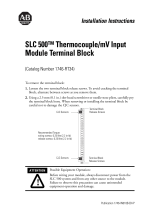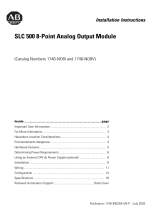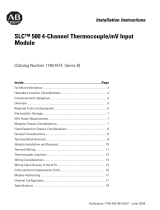
SLC 500™ RTD/Resistance Input Module 11
Publication 1746-IN012B-EN-P - May 2001
• To limit overall cable impedance, keep input cables as short as possible.
Locate your I/O chassis as near the RTD sensors as your application will
permit.
• Ground the shield drain wire at one end only. The preferred location is at
the RTD module. Refer to IEEE Std. 518, Section 6.4.2.7 or contact your
sensor manufacturer for additional details.
• Each input channel has a shield connection screw terminal that provides a
connection to chassis ground. All shields are internally connected, so any
shield terminal can be used with channels 0 to 3.
• Route RTD/resistance input wiring away from any high-voltage I/O wiring,
power lines, and load lines.
• Tighten terminal screws using a flat or cross-head screwdriver. Each screw
should be turned tight enough to immobilize the wire’s end. Excessive
tightening can strip the terminal screw. The torque applied to each screw
should not exceed 0.7 to 0.9 Nm (6 to 8 in-lb.) for each terminal.
• Follow system grounding and wiring guidelines found in your SLC 500
Modular Hardware Style User Manual, publication 1747-6.2.
When using a 3-wire configuration, the module compensates for resistance error
due to lead wire length. For example, in a 3-wire configuration, the module reads
the resistance due to the length of one of the wires and assumes that the resistance
of the other wire is equal. If the resistances of the individual lead wires are much
different, an error may exist. The closer the resistance values are to each other, the
greater the amount of error that is eliminated.
IMPORTANT
The RTD module requires three wires to compensate for lead
resistance error. We recommend that you do not use 2-wire
RTDs if long cable runs are required, as it will reduce the
accuracy of the system. However, if a 2-wire configuration is
required, reduce the effect of the lead wire resistance by using a
lower gauge wire for the cable (for example, use AWG #16
instead of AWG #24). Also, use cable that has a lower resistance
per foot of wire. The module’s terminal block accepts two AWG
#14 gauge wires.
IMPORTANT
To ensure temperature or resistance value accuracy, the
resistance difference of the cable lead wires must be equal to or
less than 0.01Ω.




















